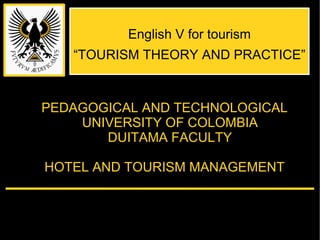
tourism theory and practice
- 1. PEDAGOGICAL AND TECHNOLOGICAL UNIVERSITY OF COLOMBIA DUITAMA FACULTY HOTEL AND TOURISM MANAGEMENT English V for tourism “TOURISM THEORY AND PRACTICE”
- 2. Presented to: Hector Garcia Lopez Presented by: Ronald Josue Rojas English V for tourism “TOURISM THEORY AND PRACTICE”
- 3. OVER VIEW Since the beginning of time humans have traveled. Food, water, safety or acquisition of resources were the early travel motivations. But the idea of travel for pleasure or exploration soon emerged. Leisure travel was associated with the Industrial Revolution in the United Kingdom – the first European country to promote leisure time to the increasing industrial population.
- 4. Tourism is a collection of activities, services and industries that delivers a travel experience, including transportation, accommodations, eating and drinking establishments, retail shops, entertainment businesses, activity facilities and other hospitality services provided for individuals or groups traveling away from home.
- 5. Mathieson and Wall (1982) " the temporary movement of people to destinations outside their normal places of work and residence, the activities undertaken during their stay in those destinations, and the facilities created to cater to their needs." DEFINITIONS OF TOURISM
- 6. MACINTOSH AND GOELDNER (1986) “ tourism is the sum of the phenomena and relationships arising from the interaction of tourists, business suppliers, host governments and host communities in the process of attracting and hosting these tourists and other visitors."
- 7. Some terms of interest Excursionist: Persons traveling for pleasure in a period less than 24 hours (Macintosh and Goeldner, 1986). Foreign Tourist : Any person visiting a country, other than that in which he/she usually resides, for a period of at least 24 hours (Committee of Statistical Experts of the League of Nations, 1937).
- 8. Travel: The act of moving outside one's home community for business or pleasure but not for commuting or traveling to or from school (Macintosh and Goeldner, 1986). Visitor: Any person visiting a country other than that in which he/she has his/her usual place of residence, for any reason other than following an occupation remunerated from within the country visited (United Nations Conference on International Travel and Tourism, 1963).
- 9. TRANSPORTATION SYSTEMS Travel has always depended upon technology to provide the means or mode of travel. The earliest travelers walked or rode domesticated animals. The invention of the wheel and the sail provided new modes of transportation. Each improvement in technology increased individuals' opportunities to travel. The type and availability of transportation will determine travel destinations. The development of accommodations were likewise determined by the development of transportation systems.
- 10. These systems are STAGECOACH (1500 A.D.) Invented in Hungary. RAILROADS (1825)First passenger train was in England. BOATS & SHIPS (early 400 B.C., but first ocean liner 1840). AUTOMOBILE (1908) Henry Ford's Model T. AIR TRAVEL (1919) by what is now know as Lufthansa Airline . SPACE TRAVEL (2015) estimated date for passenger travel into suborbital space.
- 15. Essential Requirements for Tourism Time: as the hours for leisure increase so does the opportunity for travel. Money: Discretionary income is money left over after all monetary obligations (food, rent and taxes) have been paid. Mobility: is the access to transportation and the hours required to get to their destination. Motivation: is the reason people travel.
- 16. JAFARI'S FOUR PLATFORMS Advocacy platform: 1950's - 1960's. Tourism considered an ideal activity with few negative impacts for tourist destinations. Government should promote tourism. Cautionary platform: 1970's. Proposed that tourism would eventually result in negative impacts for tourism destinations unless it was carefully planned and regulated. Adaptancy platform: 1980"s. Promoted less mass tourism and more alternative tourism. Alternative tourism included: home stays; cultural villages and volunteer tourism. Knowledge-based platform: 1990's. Promotes planning for specific tourism activities and destinations which attempt to scientifically determine impacts and capacities for tourism destinations.
- 17. Four core criteria of ecotourism A form of tourism: The most common reason for travel is visiting friends and relatives. A "tourist" will also travel outside of their normal residence and spend a specific amount of time at a destination. Basis in nature: Attractions are based primarily on a natural environment (ecosystem) or some component of that environment. It also may have a cultural component associated with the natural environment.
- 18. Learning: Visitors are motivated by the opportunity to gain knowledge or appreciation of a natural area or culture. Sustainability: It is "development that meets the needs of the present without compromising the ability of future generations to meet their own needs" (WCED, 1987, p. 43).
- 19. ECOTOURISM AND OTHER TOURISM TYPES NATURE-BASED TOURISM: Any type of tourism that relies on attractions directly related to the natural environment.. Ecotourism is a subset of nature-based tourism. CULTURAL TOURISM: Cultural tourism's focus is on the cultural aspects of a visitor's experience.
- 20. ADVENTURE TOURISM: This includes: an element of risk; a higher level of physical exertion; and a need for specialized skills to participate successfully and safely in the activity. HYBRIDS: These forms of tourism address complex and multi-faceted visitor experiences. They include: trekking, ACE tourism (adventure, culture and ecotourism); and NEAT (nature-based, ecotourism, and adventure tourism).
- 21. 3S: (SEA, SAND AND SUN) TOURISM. Tourism based mostly on mass tourism (resort). ALTERNATIVE TOURISM AND MASS TOURISM: This spans the variety of tourism form small-scale to mass tourism. One being no better or worse that the other depending on the impacts and sustainability of the activities. SUSTAINABLE TOURISM: An area of sustainable tourism that includes all ecotourism, most of alternative tourism and mass tourism.
- 22. TOURISM SUPPLY AND DEMAND I s the relationship between the quantity that tourism industrials, tourism enterprises, wish to sell at various prices and the quantity of tourism services that consumers wish to buy.